Why you can trust Tom's Hardware
Comparison Products (4TB)
The 4TB Rocket 4 Plus-G challenges the fastest drives, and some drives had to be tested at 2TB as 4TB models. Our list that includes the Samsung 990 Pro, the WD Black SN850X, and the SK hynix Platinum P41. High-end 4TB drives include the Seagate FireCuda 530, the Team Cardea A440 Pro, and the updated Sabrent Rocket 4 Plus. We include the WD Red SN700 as an example of an older, slower drive.
Trace Testing - 3DMark Storage Benchmark
Built for gamers, 3DMark’s Storage Benchmark focuses on real-world gaming performance. Each round in this benchmark stresses storage based on gaming activities including loading games, saving progress, installing game files, and recording gameplay video streams.
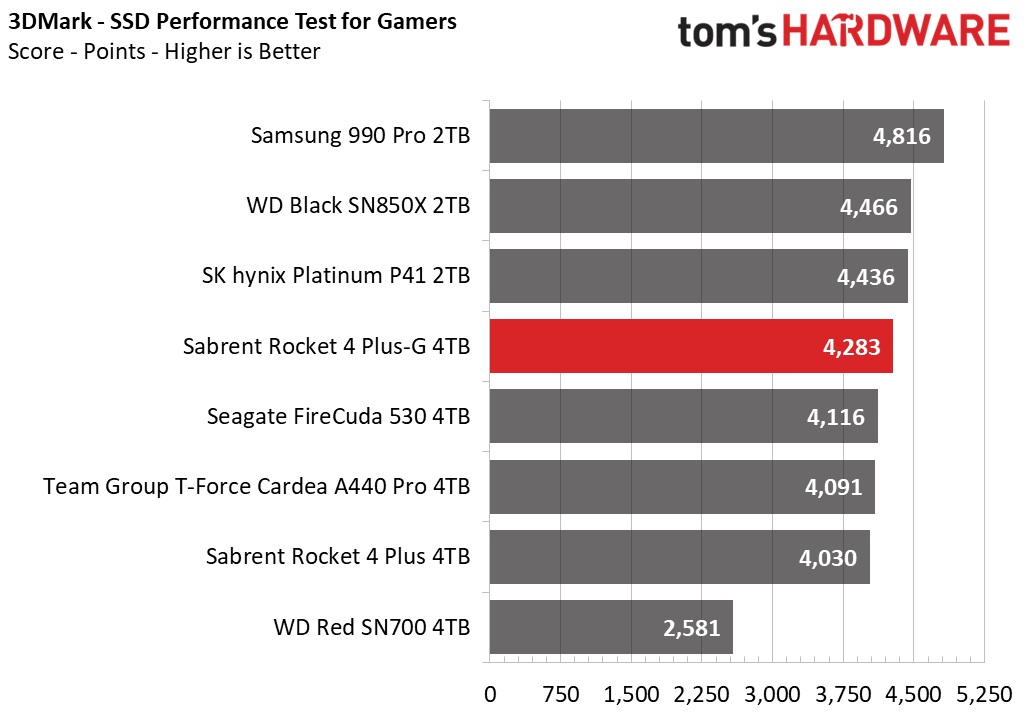
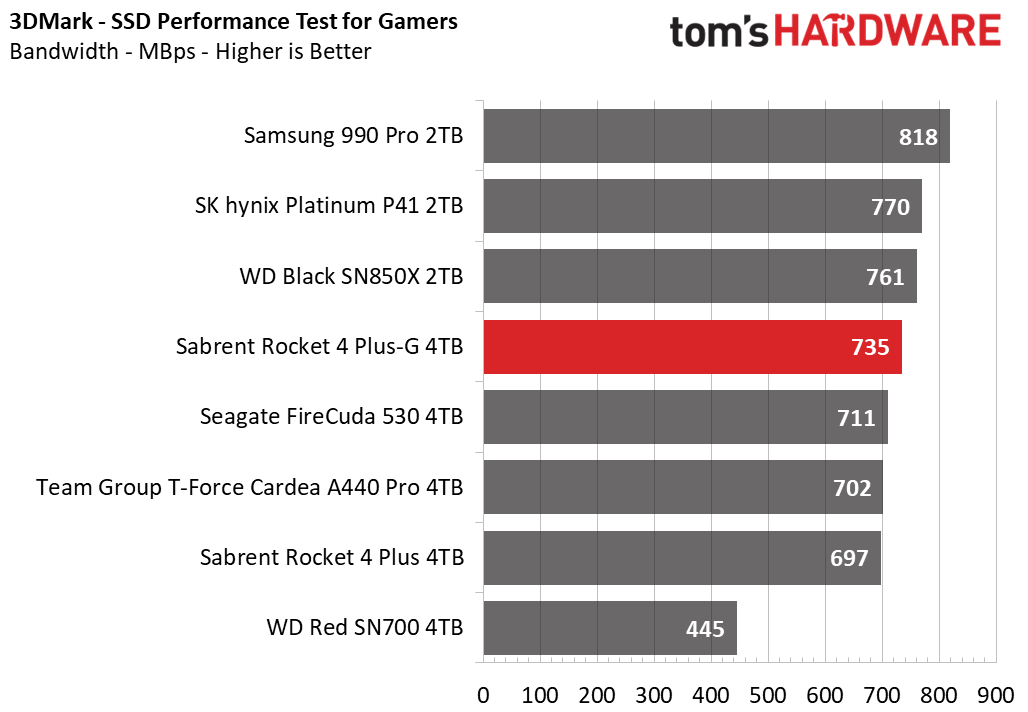
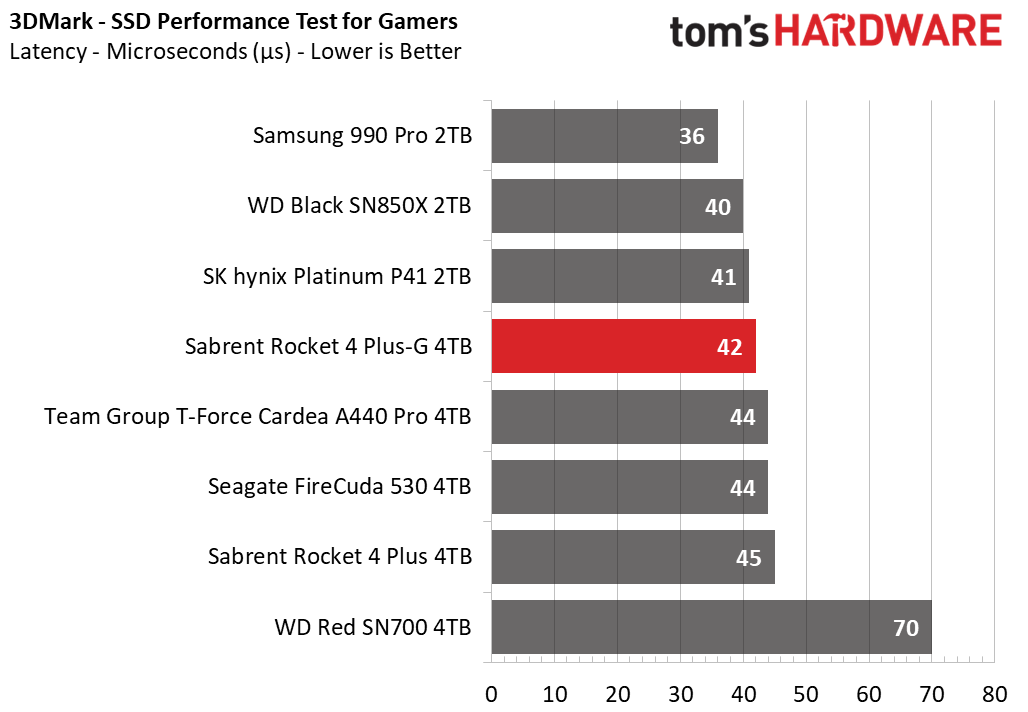
The 4TB Rocket 4 Plus-G is capable in 3DMark, but falls behind the very fastest drive — the Samsung 990 Pro is the king in this test.
Trace Testing – PCMark 10 Storage Benchmark
PCMark 10 is a trace-based benchmark that uses a wide-ranging set of real-world traces from popular applications and everyday tasks to measure the performance of storage devices.
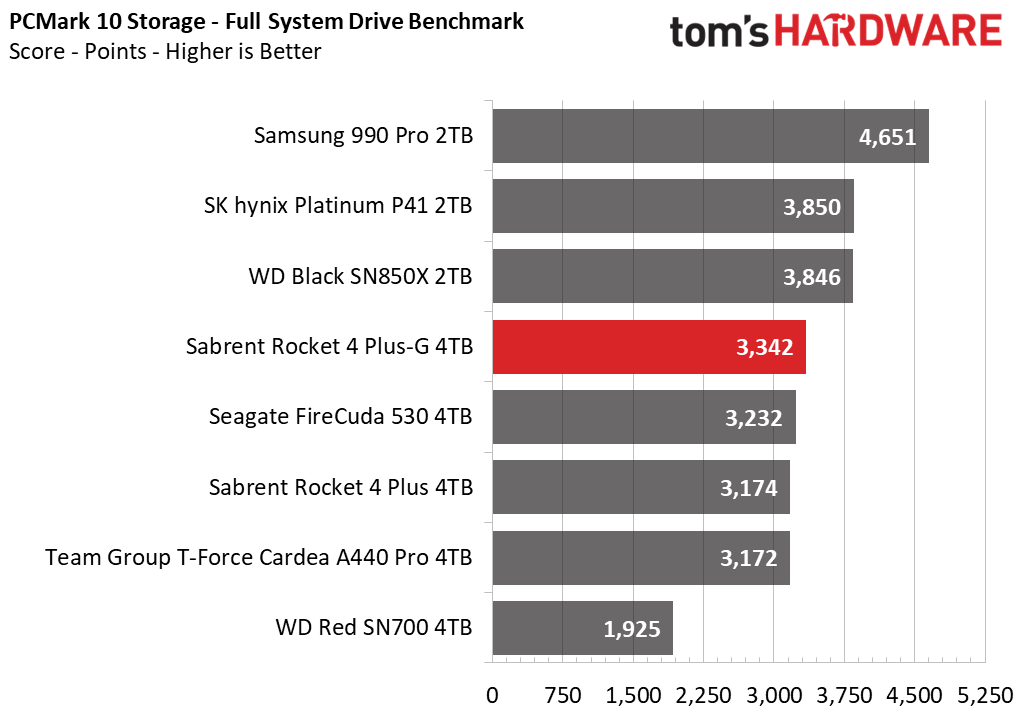
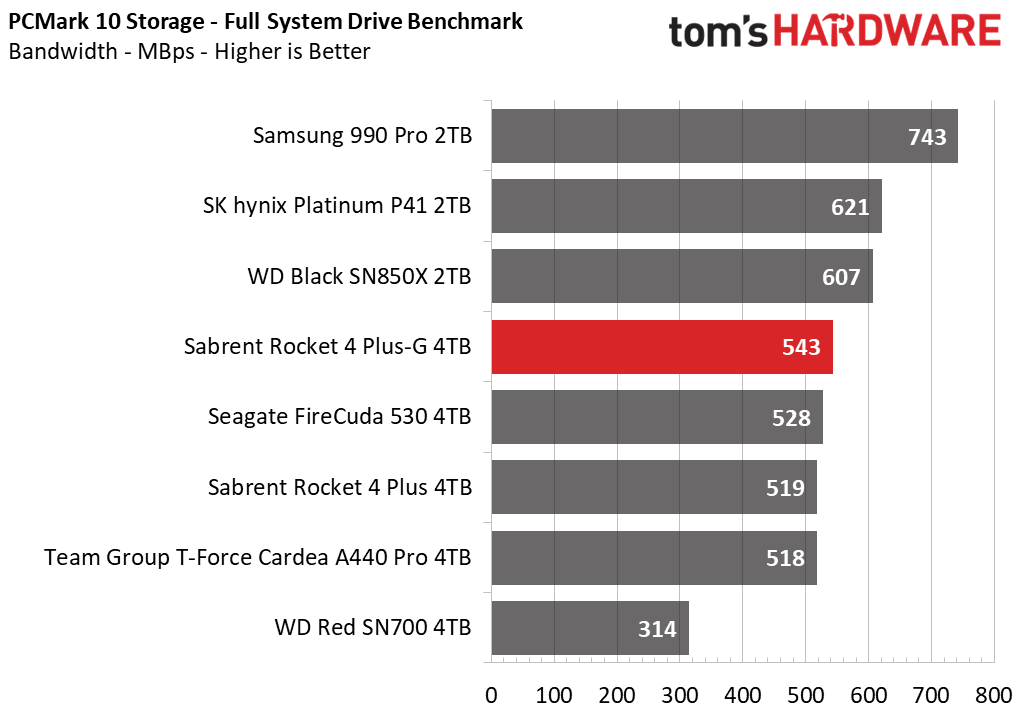
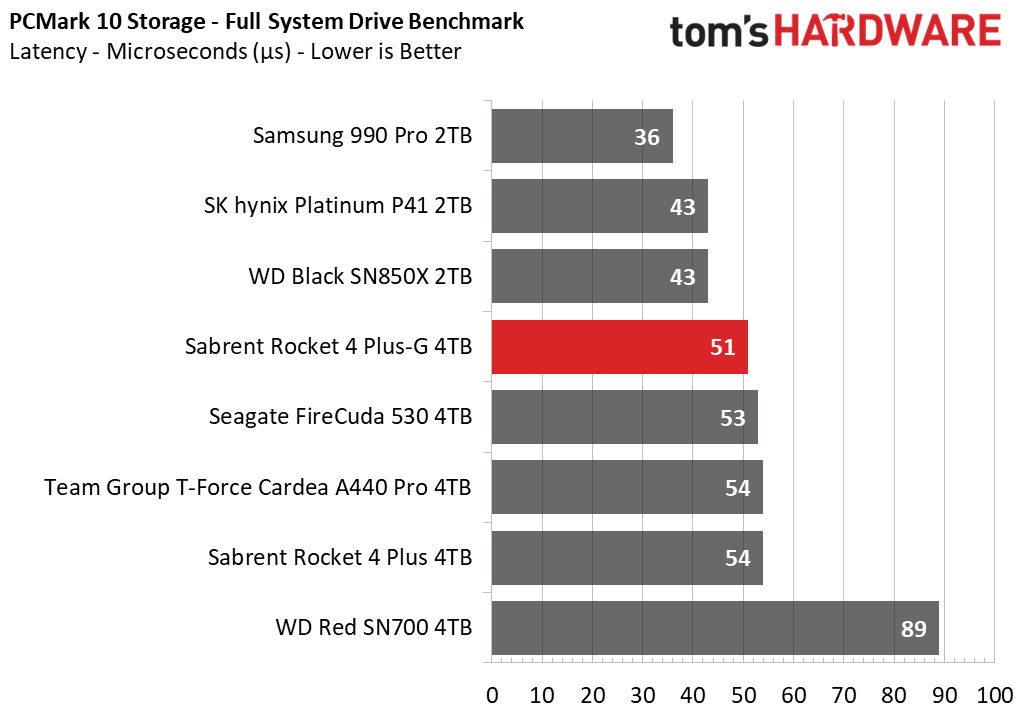
The Rocket 4 Plus-G continues trail the 990 Pro, the P41, and the Black SN850X in PCMark 10. Only the Black SN850X currently has a 4TB model available, but we have not yet tested it. The Phison controller is perhaps showing its age, but remember that those three drives are also 2TB. At a certain point, capacity can lead to a bit of reduced performance due to overhead from the amount of flash dies.
Transfer Rates – DiskBench
We use the DiskBench storage benchmarking tool to test file transfer performance with a custom, 50GB dataset. We copy 31,227 files of various types, such as pictures, PDFs, and videos to a new folder and then follow-up with a reading test of a newly-written 6.5GB zip file.
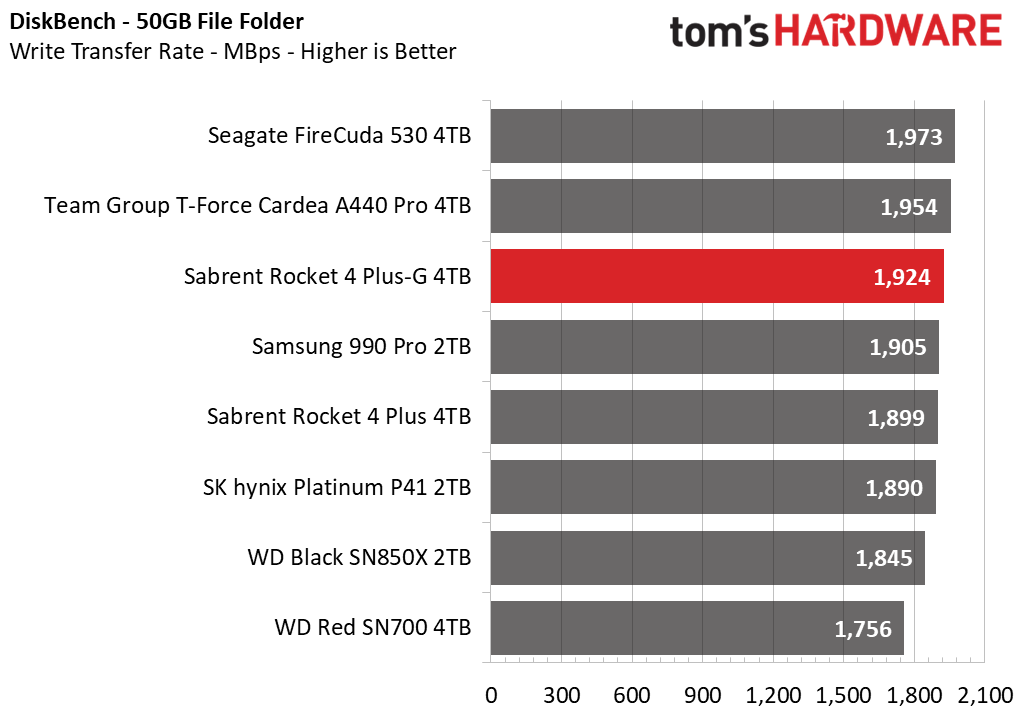
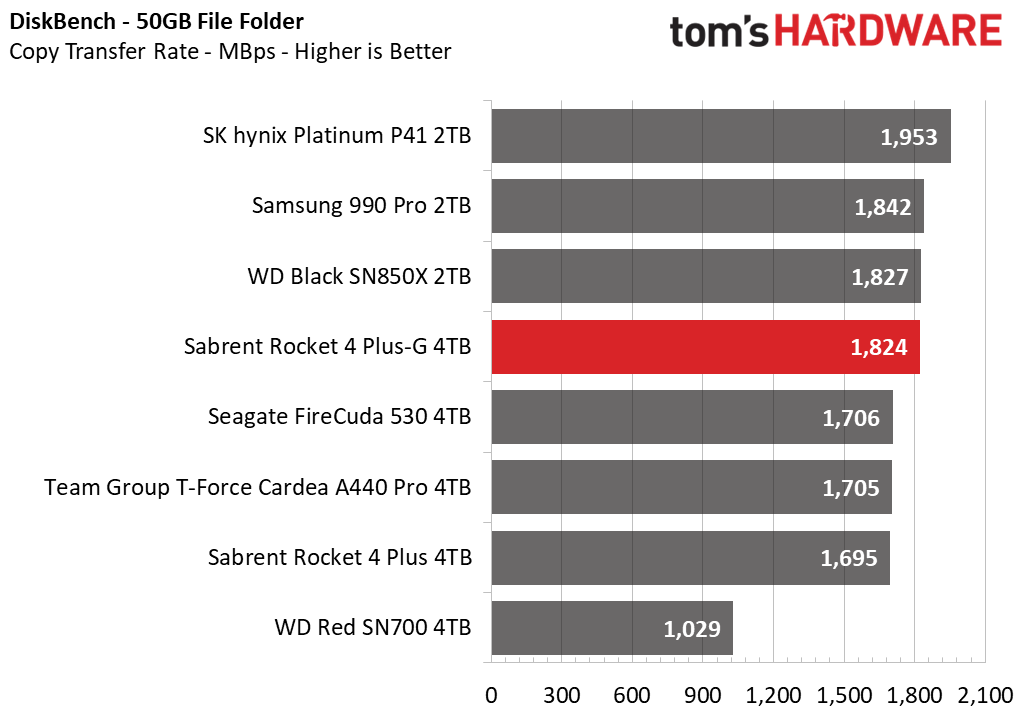
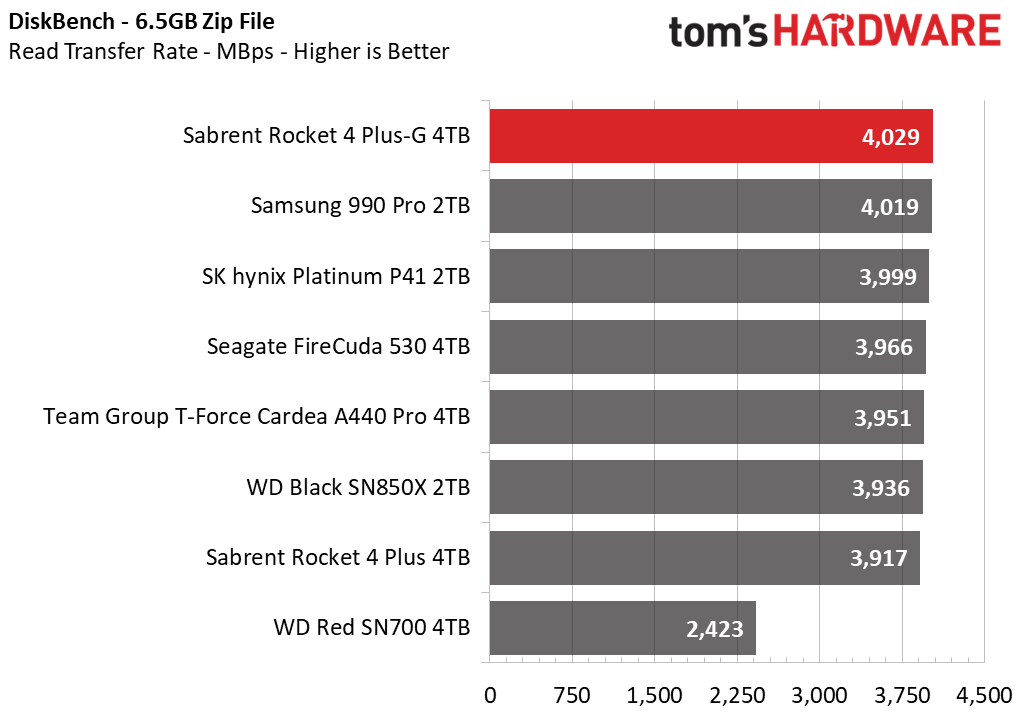
The high-end drives are all fairly close together in DiskBench as a limitation of the interface, but the Rocket 4 Plus-G is among the best. Only the Platinum P41 appears to be significantly faster.
Get Tom's Hardware's best news and in-depth reviews, straight to your inbox.
Synthetic Testing - ATTO / CrystalDiskMark
ATTO and CrystalDiskMark (CDM) are free and easy-to-use storage benchmarking tools that SSD vendors commonly use to assign performance specifications to their products. Both of these tools give us insight into how each device handles different file sizes.
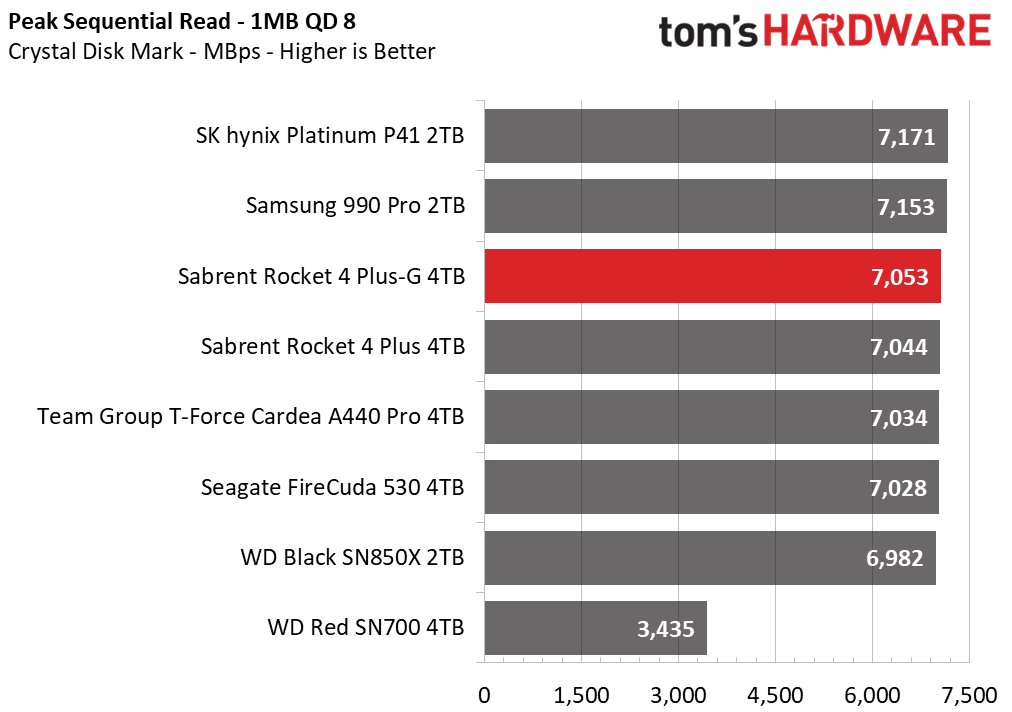
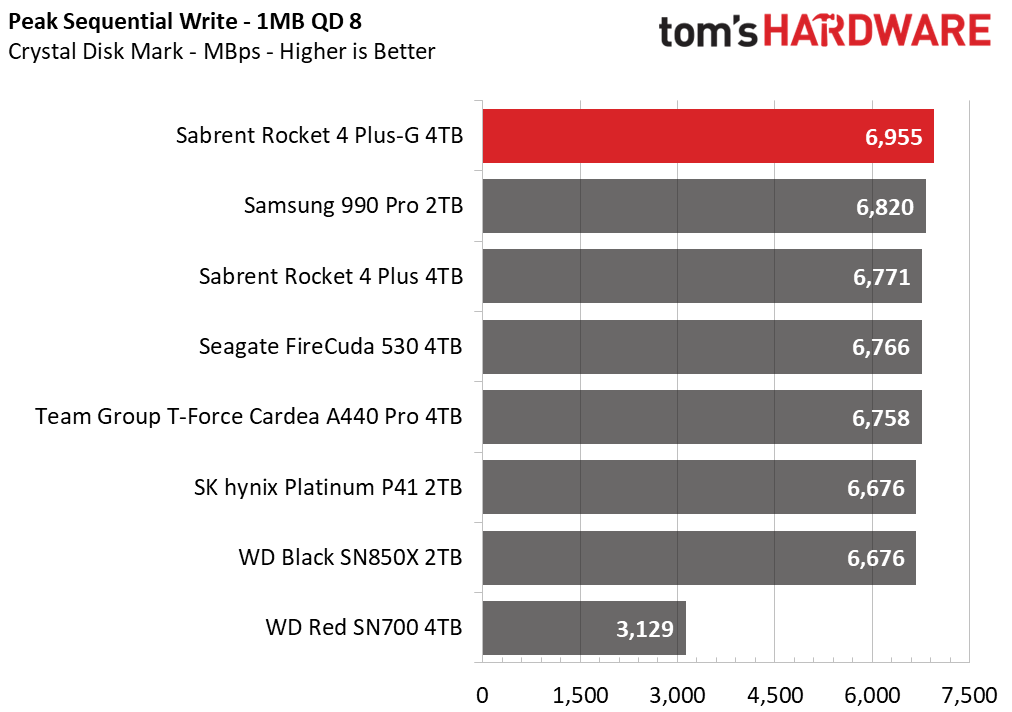
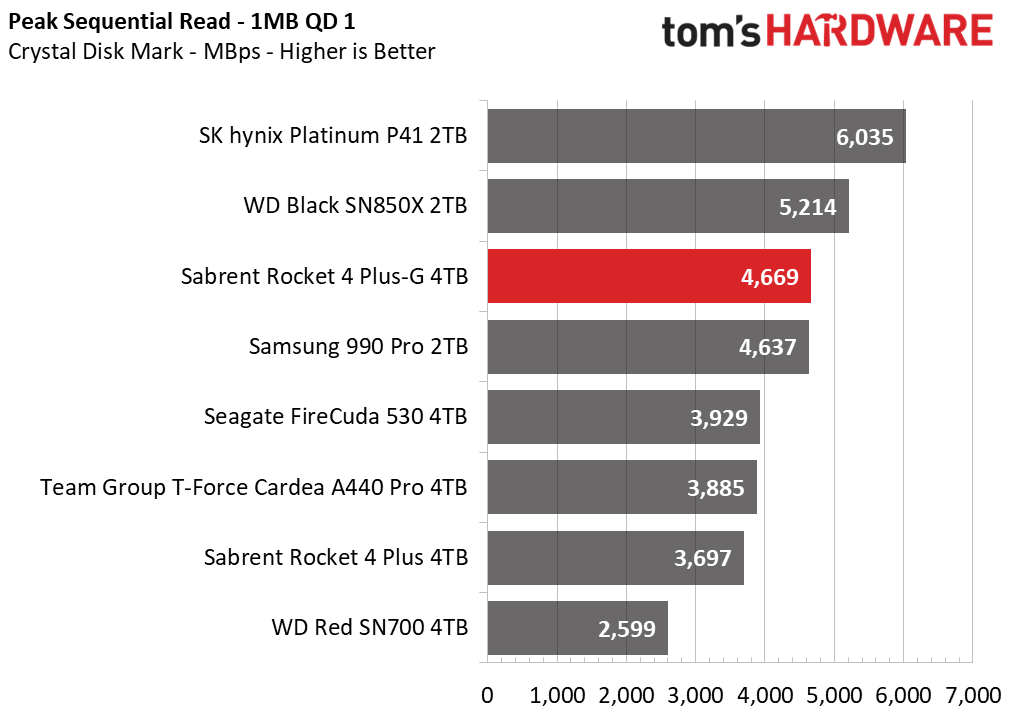
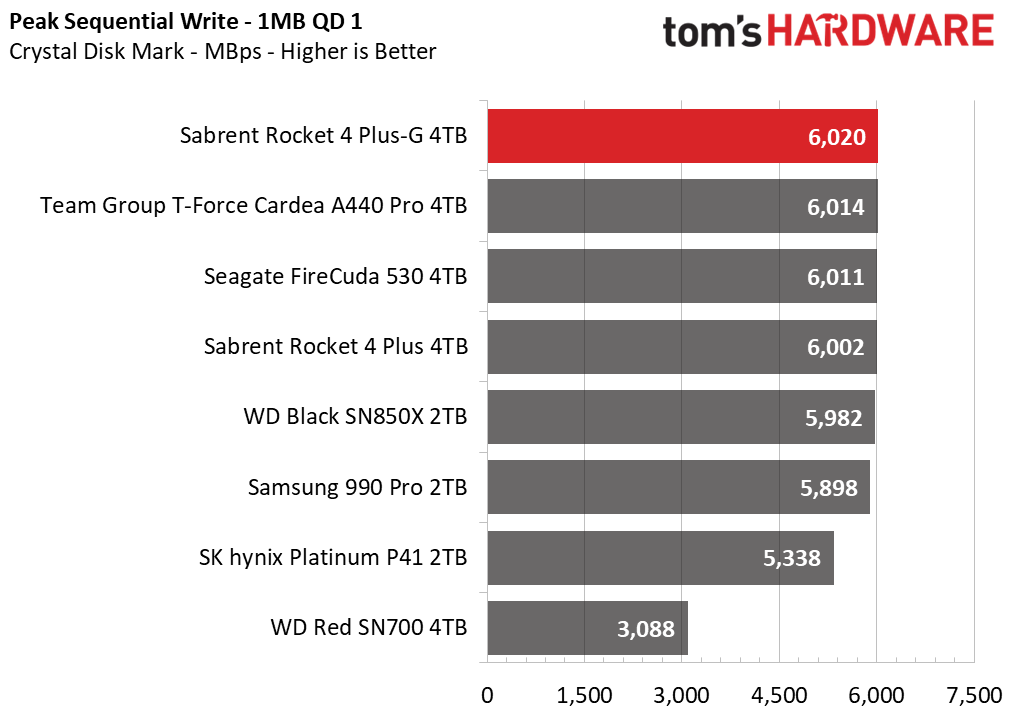
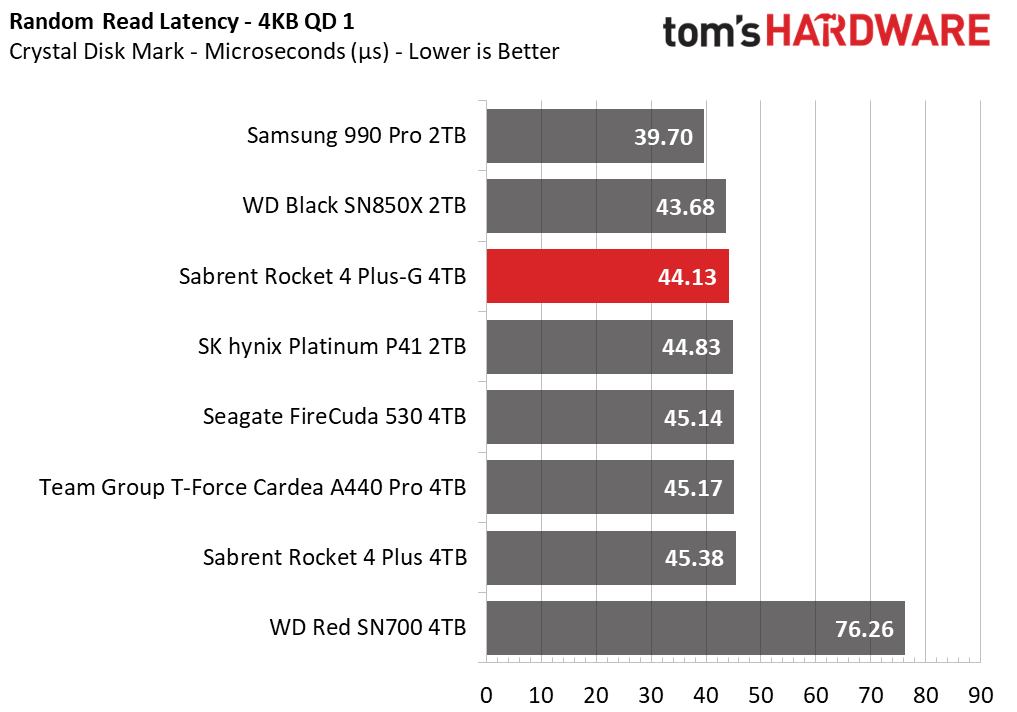
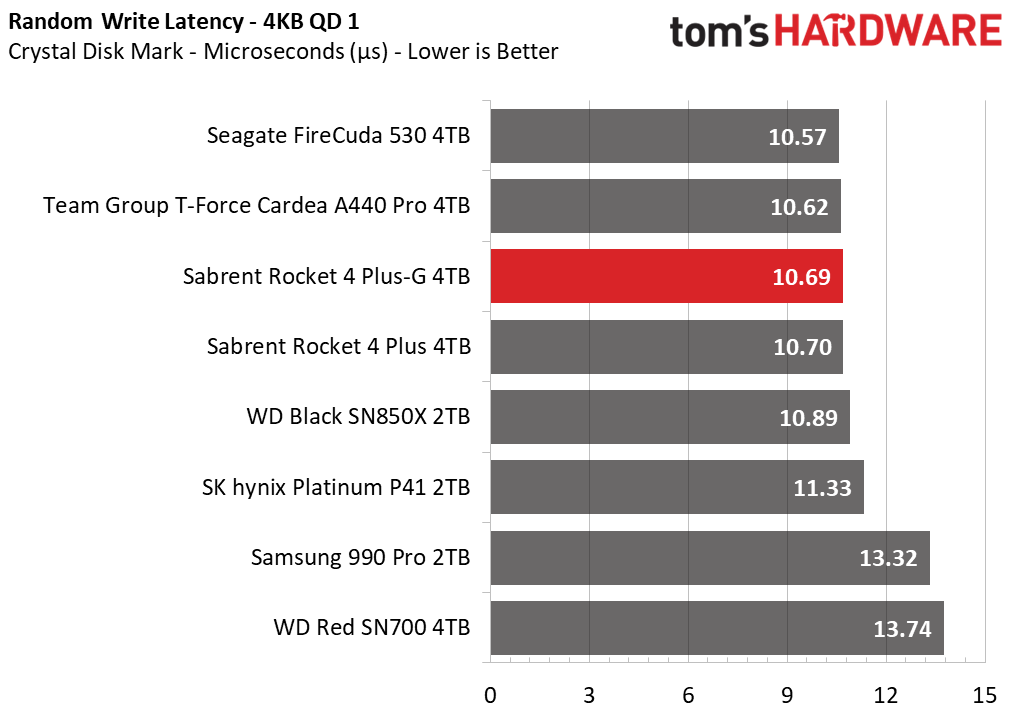
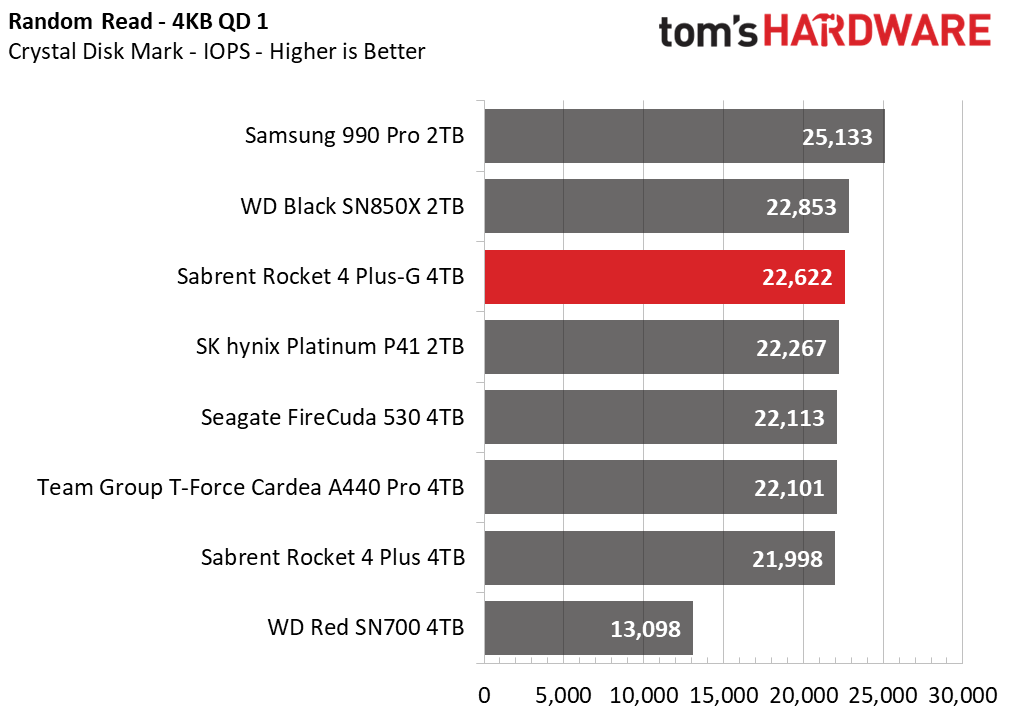
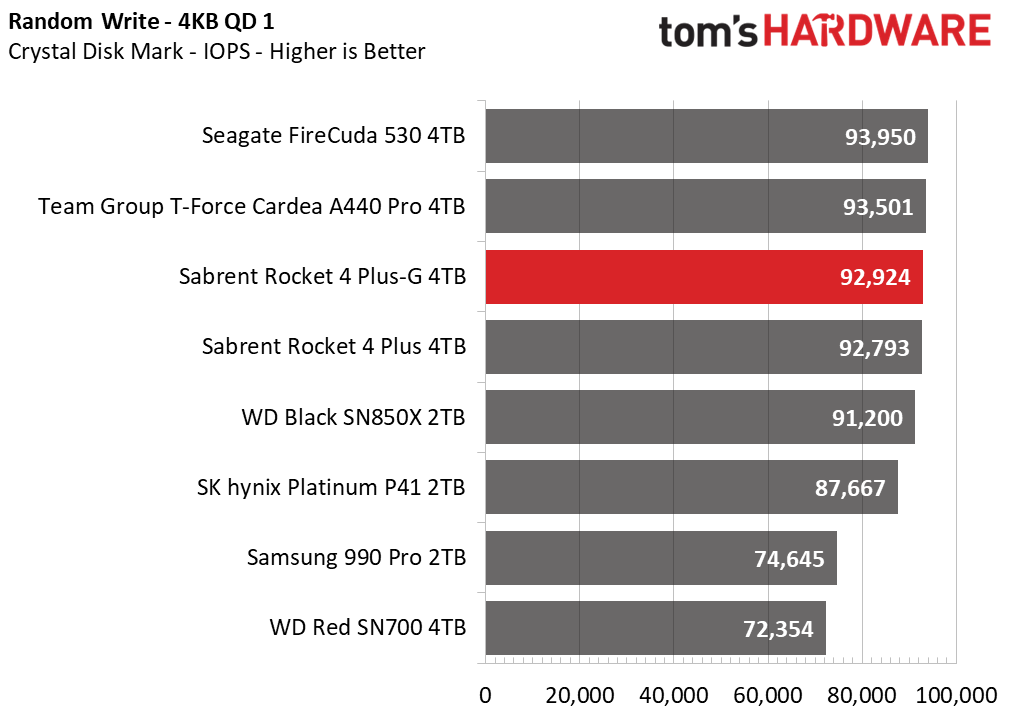
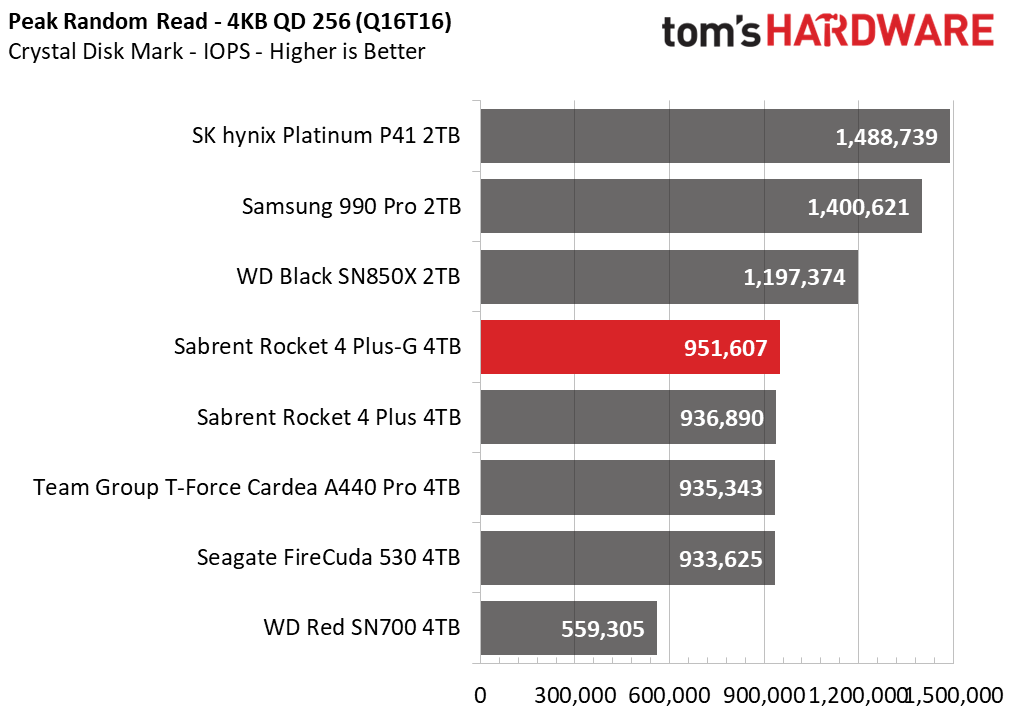
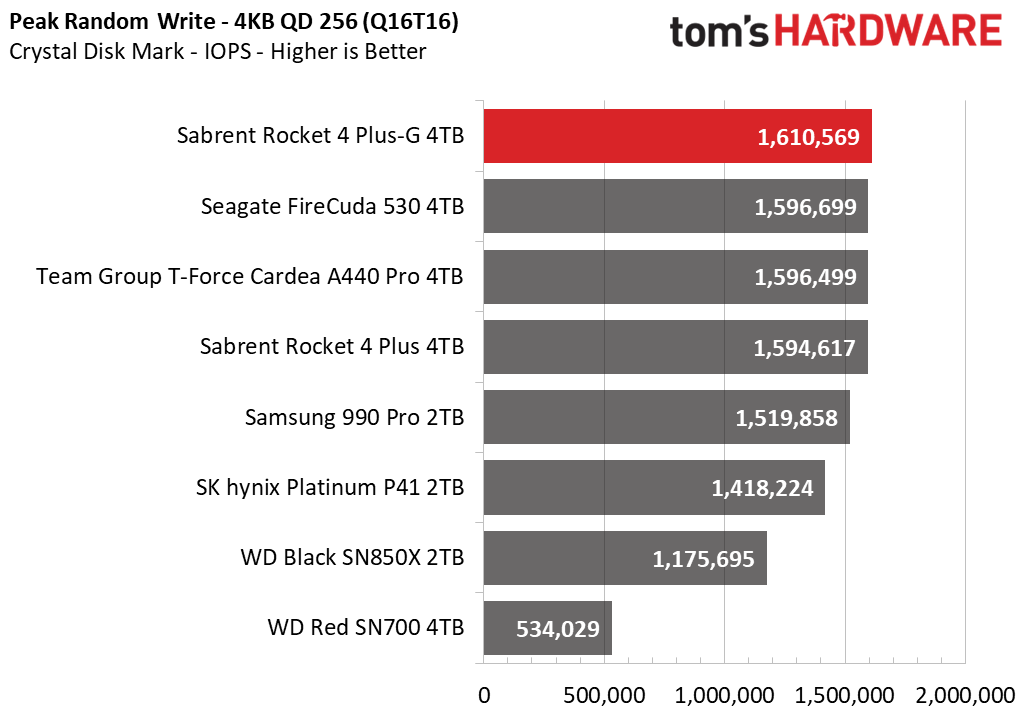
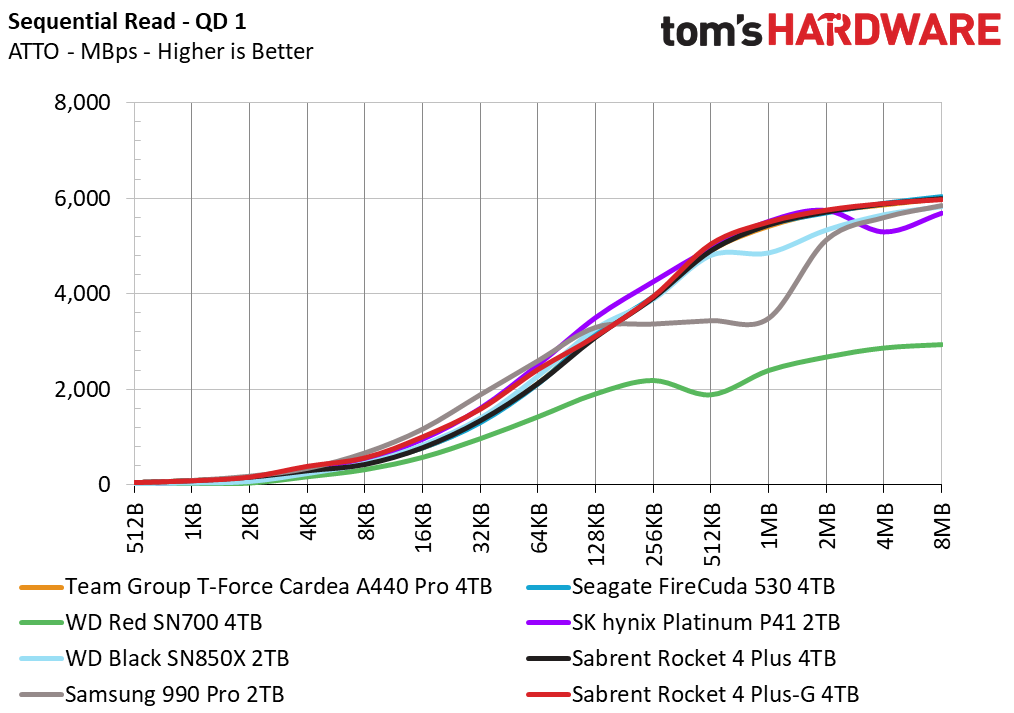
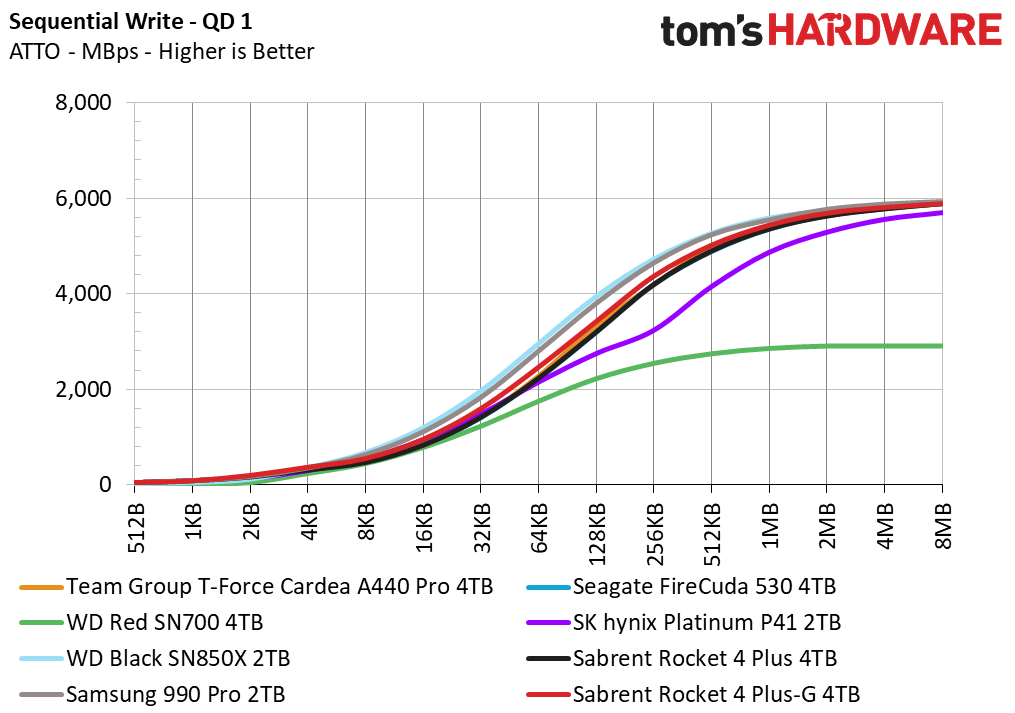
The Rocket 4 Plus-G is consistently performant in ATTO. Sequential results in CrystalDiskMark are similarly consistent with high performance. That applies to all but low queue depth read workloads — the Platinum P41 and Black SN850X edge out the drive in that particular test. 4K low queue depth performance is excellent with only the 990 Pro being significantly faster during read workloads. These results also show general improvements compared to a last-generation drive like the Red SN700.
Sustained Write Performance and Cache Recovery
Official write specifications are only part of the performance picture. Most SSDs implement a write cache, which is a fast area of (usually) pseudo-SLC programmed flash that absorbs incoming data. Sustained write speeds can suffer tremendously once the workload spills outside of the cache and into the "native" TLC or QLC flash. We use Iometer to hammer the SSD with sequential writes for 15 minutes to measure both the size of the write cache and performance after the cache is saturated. We also monitor cache recovery via multiple idle rounds.
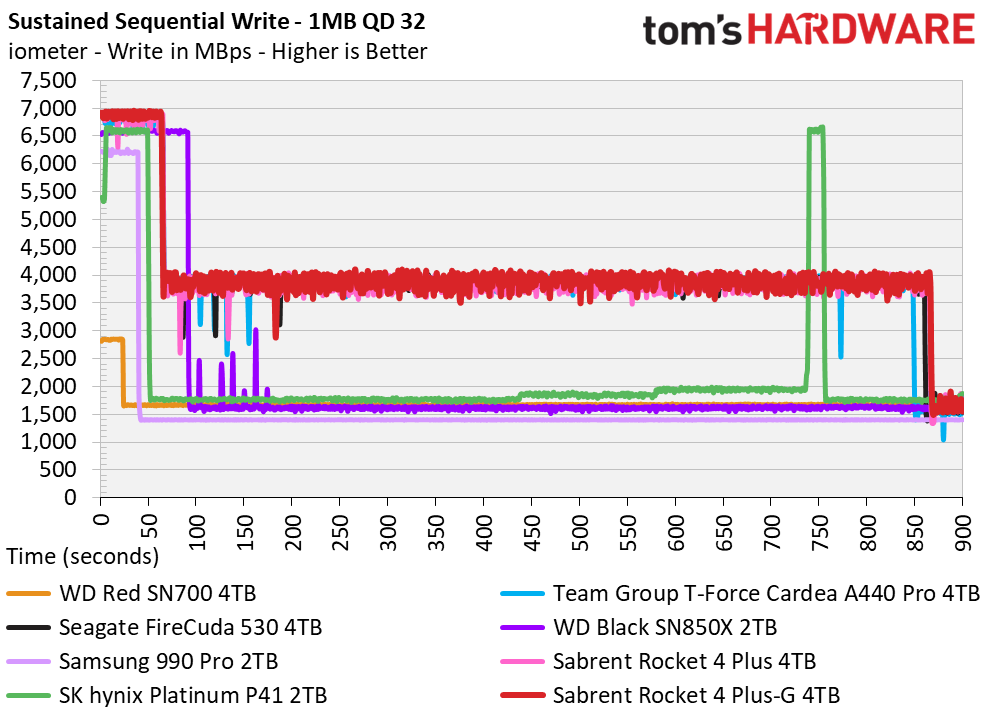
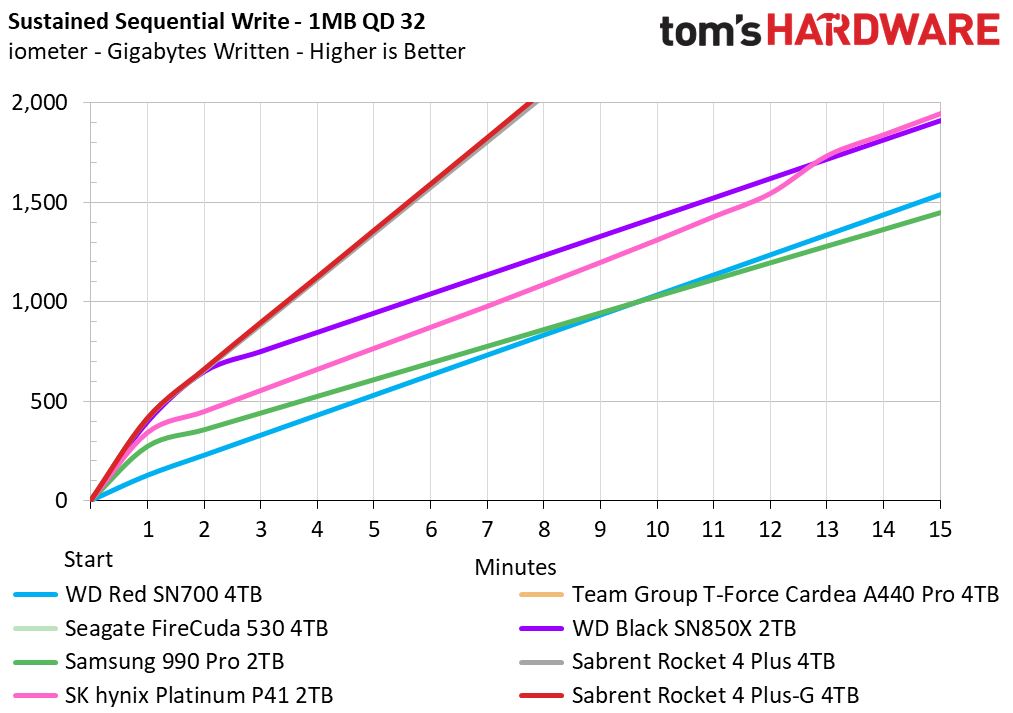
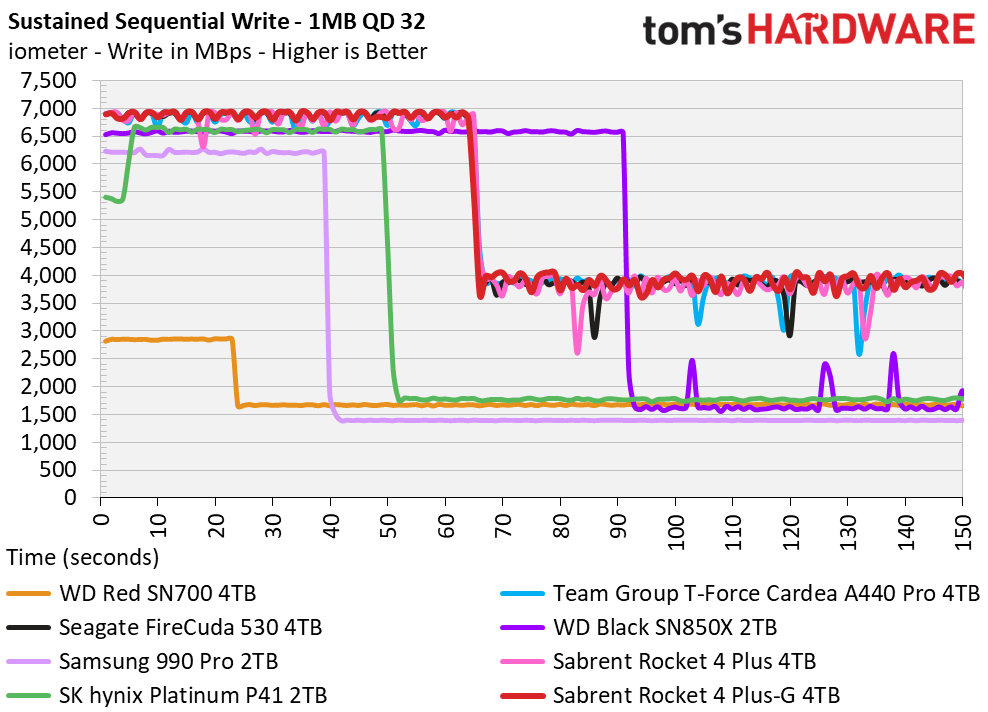
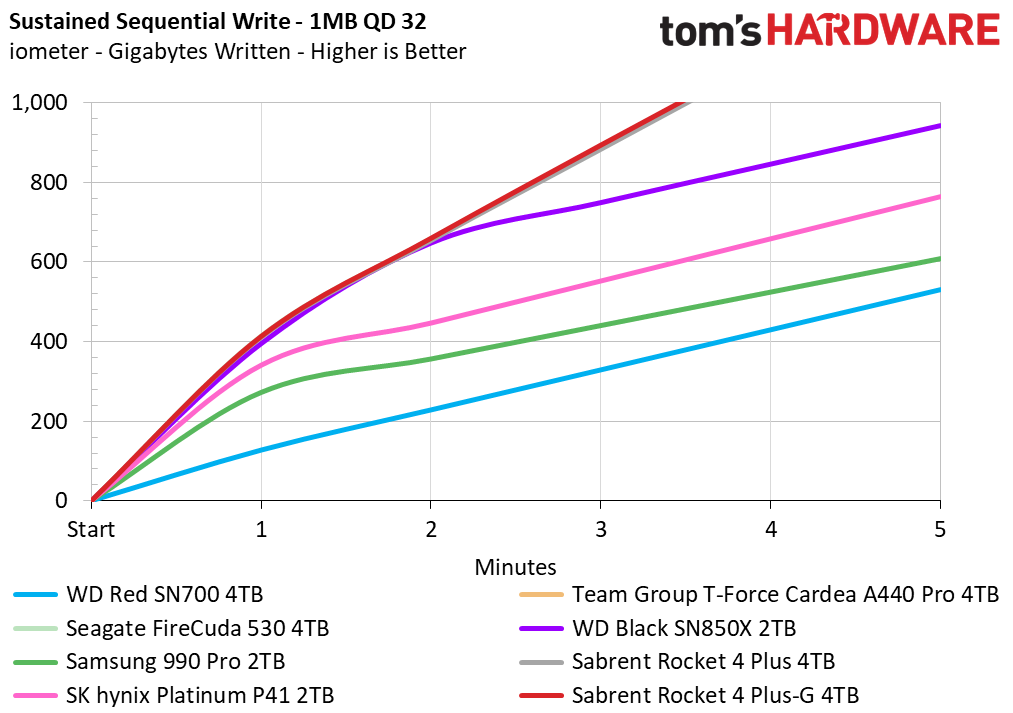
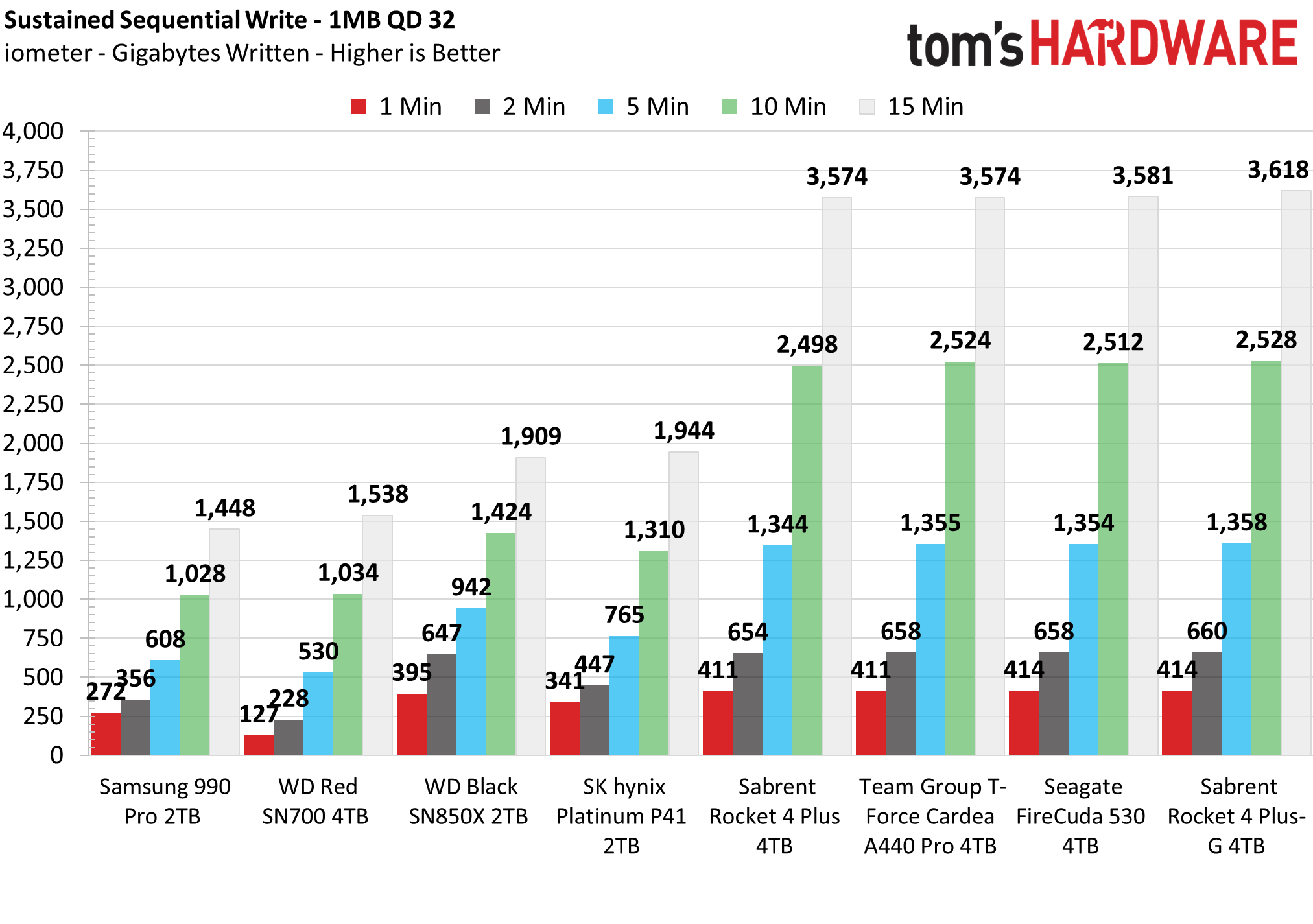
The 4TB Rocket 4 Plus-G writes in pSLC mode at 6.89 GBps for a bit over 64 seconds, suggesting a cache of around 443GB. After the cache is exhausted, the write speed in TLC mode is around 3.88 GBps. These speeds are a little bit slower than the 2TB model, as we would expect at 4TB with the required amount of dies. The drive again manages to write more over time than any other drive we’ve tested, including a bit of an improvement over the Rocket 4 Plus.
The Red SN700 stands out a bit here because it actually manages to keep up with the 990 Pro, given enough time. This is because it is a NAS drive with a conservative pSLC cache. For that type of workload, it’s still a reasonable choice if it’s priced right - particularly if you need 4TB of capacity.
Power Consumption and Temperature
We use the Quarch HD Programmable Power Module to gain a deeper understanding of power characteristics. Idle power consumption is an important aspect to consider, especially if you're looking for a laptop upgrade as even the best ultrabooks can have mediocre storage.
Some SSDs can consume watts of power at idle while better-suited ones sip just milliwatts. Average workload power consumption and max consumption are two other aspects of power consumption, but performance-per-watt is more important. A drive might consume more power during any given workload, but accomplishing a task faster allows the drive to drop into an idle state more quickly, ultimately saving energy.
We also monitor the drive’s temperature via the S.M.A.R.T. data and an IR thermometer to see when (or if) thermal throttling kicks in and how it impacts performance. Remember that results will vary based on the workload and ambient air temperature.
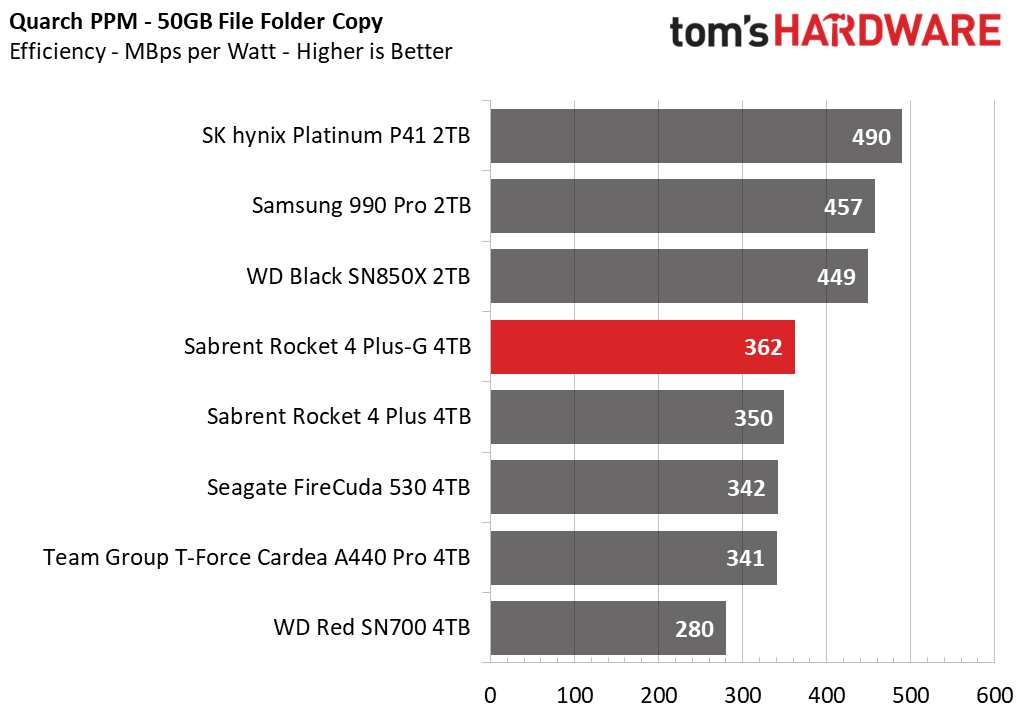
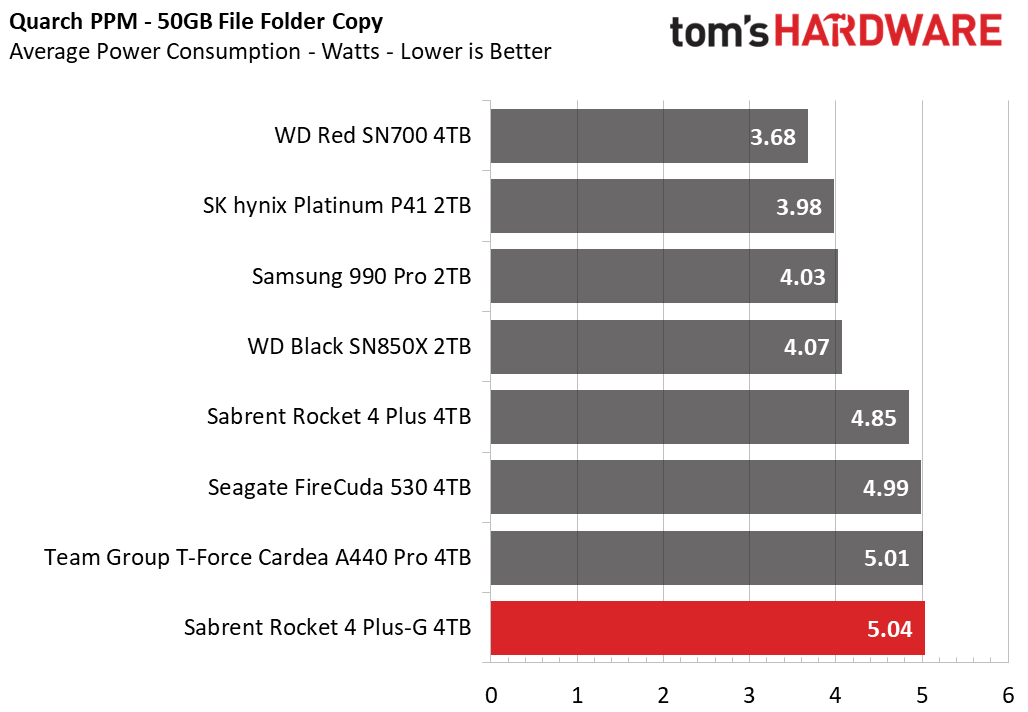
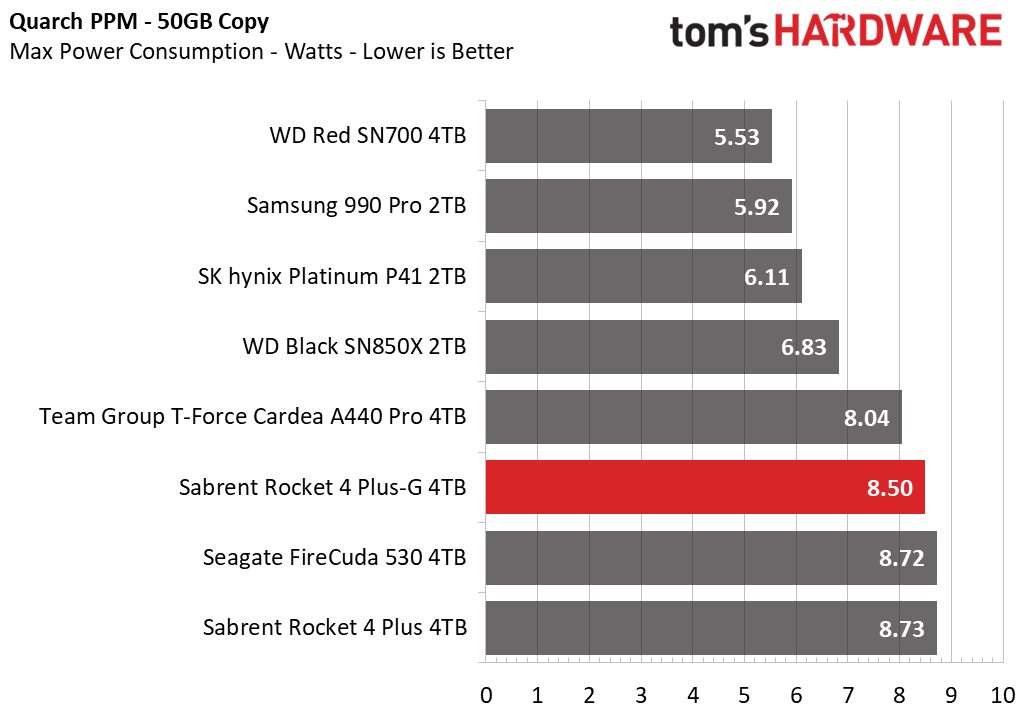
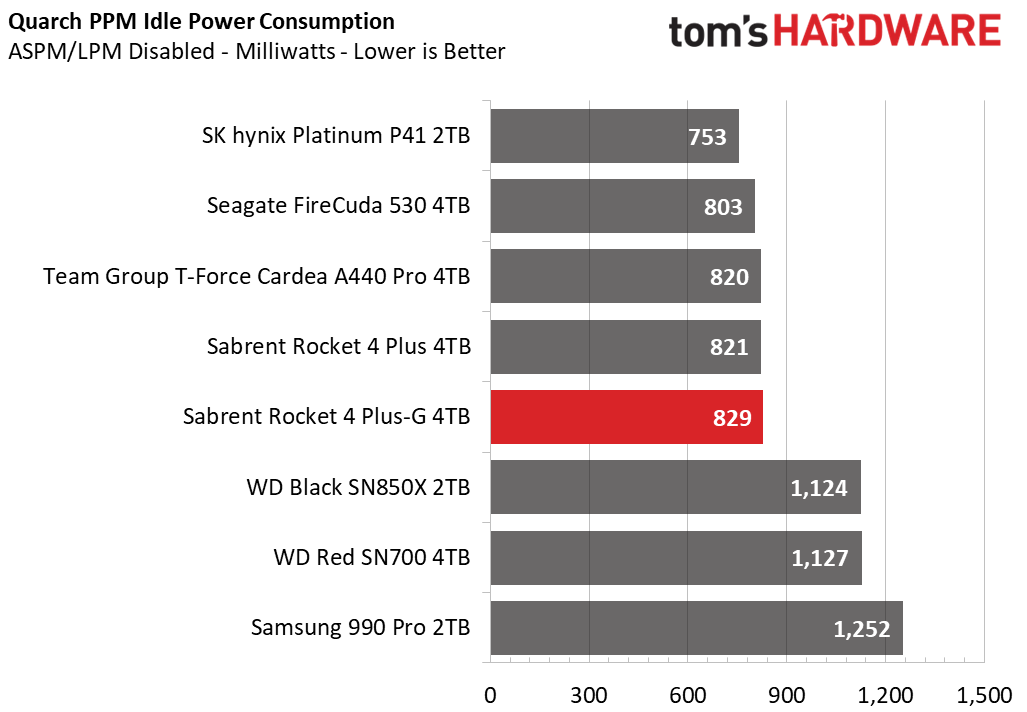
The Rocket 4 Plus-G is not very efficient, but it is the most efficient drive at 4TB. The smaller-capacity models of the drive are more efficient and so are the 2TB drives being compared here. This is a lot of storage space to pack into one M.2 drive - Sabrent managed 8TB on the Rocket 4 Plus with denser flash, and efficiency was relatively poor — so some compromises have to be made. The Rocket 4 Plus-G is also more efficient than the PCIe 3.0 Red SN700.
Using the same conditions for thermal testing as with the 1TB and 2TB, the 4TB Rocket 4 Plus-G reaches a throttling point near 78C after 730GB of writes. This is a large amount of writes, but it’s also a 4TB drive. We recommend a heatsink, if possible.
MORE: Best SSDs
MORE: Best External SSDs and Hard Drives
MORE: How We Test HDDs And SSDs
MORE: All SSD Content
Current page: 4TB Performance Results
Prev Page Features and Specifications Next Page 1TB Performance Results
Shane Downing is a Freelance Reviewer for Tom’s Hardware US, covering consumer storage hardware.
-
DavidLejdar "questionable how useful DirectStorage will be"Reply
As end-user I know so far only that Win11 is recommended for DirectStorage (it is compatible with Win10, but Win11 has the latest storage optimizations build in - according to the dev blog). And the big feature is the GPU decompression, which they say can speed up loading by nearly 3x when the CPU is a bottleneck. But so far I haven't seen any info about what CPU they used - e.g. the screenshot on the dev blog just says "100% Max CPU usage" for the part without GPU decompression. What about latest CPUs though? Will a system with a new CPU still have some use for DirectStorage, or can the CPU actually handle it without?
On the other hand, that part could be tested already. Like when someone happens to have a rig with a top-performing CPU, does that CPU hit 100% usage when loading a game? If so, then one could argue that (even) a high-end system may benefit from DirectStorage - based on the info provided so far.
For me, who is likely to get one of these 4.0 SSDs, it would still leave a question though, of whether a NVMe SSD with firmware designed for DirectStorage gives that much a boost that it would be at least on par with a bit faster NVMe SSD in regard to game loading. -
PlaneInTheSky Allow me to be sceptical of "DirectStorage", or rather Microsoft its claims.Reply
The latest consoles have "DirectStorage". There might be some differences (consoles use shared memory), but overall it's quite similar tech to that coming to PC.
It allows system memory to bypass CPU overhead, and allows the GPU's parallel processing prowess to be used for texture decompression.
Yet loading speeds on consoles are not noticeably faster than on PC. The excuse so far has been that developers need to implement it. Yet if it was as straightforward to implement as claimed, where are all these titles on consoles with "almost instant loading time". Either DirectStorage is overrated, or implementing it seems so complex that developers aren't actually adding support to games. -
USAFRet Reply
Until we see the hardware in the wild, with applications actually created to take advantage of this DirectStorage....all is speculation.DavidLejdar said:"questionable how useful DirectStorage will be" -
umeng2002_2 The other issue is that some games don't dedicate enough CPU threads to decompression. So a 6 core or 16 core might only still use 2 threads to decompress assets. A dev now COULD really speed up loading, but many of them don't see it as a priority. When DirectStorage finally get FULLY released, it should be easy for devs to implement it in their games.Reply -
LastStanding Reply
That's the thing about being fully confident and having the full support to back it up to prove your claim (on release by having some titles ready to go when DS1.1 launches, not weeks/months later, to show off its prowess, and not the arrogant... "take a look at our skids and just take our word for it" nonsense) on day-0 of its deployment, especially knowing that MS has a very bad track record for under delivering on their promises. e.g. Game Mode, HAGS, Mesh Shader, etc.USAFRet said:Until we see the hardware in the wild, with applications actually created to take advantage of this DirectStorage....all is speculation. -
umeng2002_2 This technology is being used right now with the PS5 and Xbox whatever it's called... Sony doesn't really specify much more than just a sequential speed rating.Reply -
saunupe1911 Nope my next gen drive will be a 990 Pro. I will never buy a Sabrent drive again. Plus Samsung's software suite is the best in the business.Reply -
hannibal Like all new features, this will take time to be used in multiple applications. Games and other programs will be developed normal SSD as a target. Eventually there will be more and more programs that really would benefit from this feature. But it will take time, most likely years until this is feature you need, instead of nice to have.Reply -
Hortos I'm hoping its an issue of they know no PC currently can use the feature so they don't bother implementing it on any crossplatform game that will run on PC.Reply